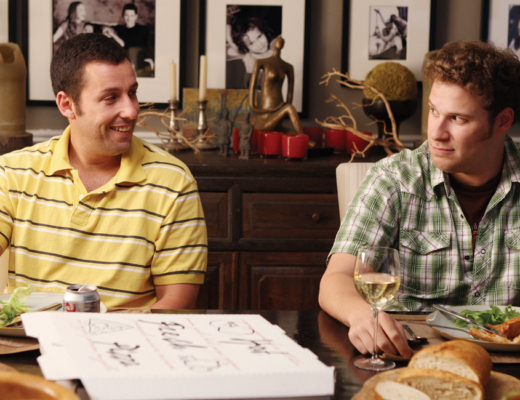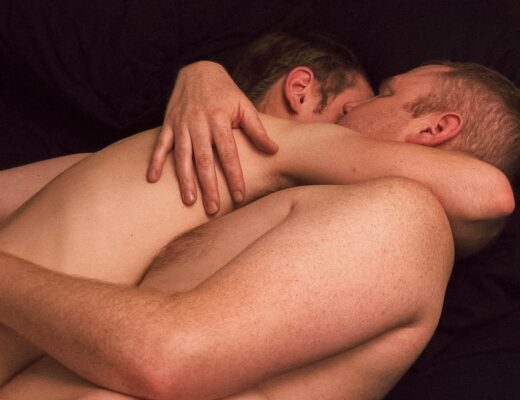André De Toth is one of the great, unsung directors of Hollywood’s Golden Age. As Fred Camper noted in a 1997 essay bemoaning his lack of stature, De Toth receives only a cursory nod in Andrew Sarris’s canonical The American Cinema, with barely a paragraph of vague commentary, and he isn’t included at all in the 1984 International Directory of Films and Filmmakers. Curiously, he isn’t mentioned in the Library of America’s Complete Film Writings of Manny Farber, either — a surprising absence given Farber’s predilection for hard-hitting, unpretentious, termite art and fondness for actor Robert Ryan. Never as prolific as his contemporaries in the ’40s and ’50s, where an entrenched studio system allowed (or demanded) that filmmakers churn out multiple films per year, De Toth worked at a slower pace, happy to take his time between pictures. He’s perhaps best known in some circles for his tumultuous marriage to actress Veronica Lake, or amongst horror aficionados as the director of the original House of Wax (1953), a perennial Vincent Price favorite and the first color 3-D film from a major studio. Eventually, De Toth became a script doctor and 2nd unit director, laboring mostly anonymously on Lean’s Lawrence of Arabia and supervising the flying sequences in Richard Donner’s Superman. The fine director and critic Bertrand Tavernier was a fan, at least, and the last few years have brought home video releases that have slowly but surely allowed viewers to acquaint themselves with De Toth’s harsh, dour worldview.
Day of the Outlaw, a low-budget Western from 1959, was one of the last films De Toth would direct in America, and it’s one of his finest works, a “psychological” Western that stands tall alongside the better-known works of Anthony Mann, Nicholas Ray, and Bud Boetticher. In Outlaw, De Toth paints a damning portrait of the scarcely-submerged violence inherent in polite civilization, where social niceties barely conceal murderous impulses, juxtaposing the folks of small-town Bitters, Montana with a roving band of rabid criminals. “Town” might be too grandiose a term, however, as Bitters consists of a hotel, a general store, and a barber shop, all positioned at the literal end of the trail, where an unpassable mountain range begins. Cattleman Blaise (a tough, taciturn Robert Ryan) is locked in a bitter feud with local farmer Hal (Alan Marshal), who has begun stringing up barbed wire fences to keep herds out of his fields. Blaise wants his cattle to have free roam, and insists that it’s men like him that have allowed civilization to take root here. He believes the farmers are weak, cowardly men who never had to get their hands dirty yet have profited from others’ hard (read: murderous) work. Hal believes that farming is the way of the future, and that violent men like Blaise don’t have a place in the world anymore. The pair are about to face off when Bruhn (a fearsome Burl Ives) and his gang burst onto the scene, as if summoned by some cosmic force. It’s a brisk, efficient setup, clearly delineating Blaise and Hal’s personalities, as well as that of Hal’s wife, Helen (the remarkable Tina Louise), who has a romantic history with Blaise.
It’s the stuff of potent melodrama that quickly gives way to a siege film, as Bruhn demands room and board for his motley crew. As the gang settles in, it becomes clear that they covet the townswomen, and if given a chance, would rape them all (naturally, this being a film from 1959, the word rape is never uttered, but De Toth still trots out a number of euphemisms, leaving no doubt about what could transpire). Blaise springs into action, casually suggesting to Bruhn that he could lose his men to infighting if they begin arguing over women, and further needling him by hinting that perhaps Bruhn isn’t tough enough to actually control those under his command. That’s all it takes for Bruhn to order his men to leave the women alone, along with hiding the town’s stash of hard liquor. But Bruhn is also injured, and Blaise fears that if he dies, the men will be free to pillage the town and it’s inhabitants.
Here, then, are multiple, tension-filled threads that threaten to spiral out of control: the townsmen simultaneously trying to figure out how to hide the women while keeping Bruhn alive, and Bruhn’s men conspiring behind his back to get their hands on both the booze and the women. This culminates in a nightmarish scene where Bruhn allows his men to conduct an impromptu dance with the women. Believing the outlaws will behave themselves under his watchful eye, they proceed to manhandle the women in a dark simulacrum of courtship, which De Toth films in swirling, nauseating 360 degree pans. — it’s a demonic inversion of a favorite Fordian trope. As Bruhn’s health continues to falter, Blaise concocts a plan to get the gang to follow him out of town and through a mountain pass to freedom. Only Blaise knows that no such trail exists, and he’ll be leading these men through a winter storm to not only their certain death, but also his own. It’s a noble sacrifice, which De Toth suggests is the price for Blaise to redeem himself to the townspeople — society can only progress once he’s been martyred.
Tavernier has called Day of the Outlaw “Dreyer-esque,” while Jonathan Rosenbaum has compared De Toth’s sensibility to another Hungarian miserabilist, Bela Tarr. Both are apt comparisons, as De Toth emphasizes a bleak, bare minimalism, with high contrast black and white photography casting a monochromatic hue over the proceedings. Long shots of figures pressed against the flat landscape give way to extreme closeups, with beaded sweat and leering eyes filling the frame. Building interiors are largely barren, with tables and stairs bisecting the frame and mirrors unbalancing the image. Reflections and doublings are important motifs, as these mirrors allow De Toth to shoot Blaise or Bruhn in isolation while the faces of the people they address are visible in the reflective surfaces. De Toth also has Blaise and Bruhn each deliver monologues in separate scenes from atop stair cases, looking down on the spectators below. This links the men visually while suggesting that each fancies themselves a kind of king. Of course, once Blaise leads the bandits into the snowy wasteland, the landscape renders all the men equally anonymous; nature has all real power here, and it is unforgiving. Camper writes that “De Toth’s artistry lies… in a subtle visual dialectic between two extremes, the human being as unique individual and as an anonymous actor in a preordained drama of brutality, betrayal, and decimation.’” That Blaise survives the dangerous trek and returns to town victorious could be read as a happy ending, but De Toth undercuts even this brief moment of optimism. Blaise enters a building without noticing any of the people he’s managed to save, shutting the door behind him. Reflected in the window are the ominous mountains, now home to a litany of fresh corpses. Much like Ethan Edwards leaving the homestead at the end of Ford’s The Searchers, Ryan’s brutal cattleman can no longer be a part of the society he has helped build. Blaise has become the “anonymous actor” in this drama, his part played out, his usefulness over. Perhaps he died in the mountains after all.
Part of Kicking the Canon – The Film Canon.







